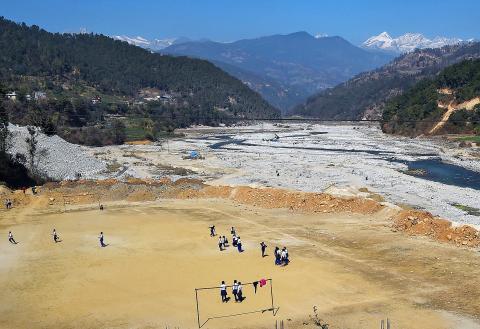Living the high life — growing up, in other words, at extreme altitude — forces a developing human body to conserve energy, and that can translated into shorter arms, according to a study published Wednesday.
Nepalese men and women born and raised at 3,500 meters and up are more likely to have curtailed forearms compared to people of similar ancestry from lowland areas, scientists reported in the journal Royal Society Open Science.
Intriguingly, adjoining parts of the anatomy — the upper arms and hand — remain the same for both groups.

Photo: AFP
A similar pattern was uncovered in earlier research among Peruvian children, reinforcing the notion that harsh mountain conditions were somehow responsible.
“It was interesting to see that they both followed the same growth patterns,” lead author Stephanie Payne, a biological anthropologist at the University of Cambridge, said.
The findings raise a host of questions, starting with this one: What is it about an high-altitude living that makes the body shape-shift?
“This is most likely an adaptation to improving oxygen uptake,” Payne said.
For similar reasons, indigenous peoples of the Himalayas and Andes often have barrel chests, the better to expand lung capacity and take in more oxygen.
Although air contains 21 percent oxygen at all altitudes, it feels as if there is less of it in the mountains due to lower air pressure.
Using the measure of “effective oxygen”, the level drops by just under 40 percent at 3,500 meters compared to sea level.
In high-mountain regions, low oxygen availability results in inefficient conversion of food into energy, which means that there is less energy available for growth. This become especially true when combined with a nutrient poor diet.
NOT EVOLUTION
But what possible advantage is there to diminished forearms and lower legs, which also tend to be foreshortened among mountain-folk? And why not other parts of the body?
It is not so much that there is something to gain, but more that there is nothing lost, the study conjectured.
“The human body prioritizes which segments to grow when there is limited energy available for growth, such as at high altitude,” said Payne.
“The full growth of the hand may be essential for manual dexterity, whilst the length of the upper arm is particularly important for strength.”
But a shorter lower arm is apparently something humans can live with.
To conduct the study, Payne and colleagues from Nepal and Canada trekked for two days — with yaks hauling scientific equipment over mountain passes — to Namche Bazaar on the Everest Trail, getting more than a taste of altitude sickness along the way.
Humans, like all living creatures, change in response to evolutionary pressures through the process of natural selection. Chance genetic mutations that turn out to confer an advantage enhance the chances of survival, and of being passed along to offspring.
But Payne doubts that evolution is at work in this case. Rather, she said, the bodies of people born into the rarefied atmospheres of the Andes or the Himalayas react and adapt in real time, probably from the fetal stage.
The exact biological mechanism, however, resulting in shorter forearms remains a mystery.
“It might be related to temperature changes or altered blood flow down the limb during growth, or differences in nutrient delivery between limb segments,” said Payne.

May 18 to May 24 Pastor Yang Hsu’s (楊煦) congregation was shocked upon seeing the land he chose to build his orphanage. It was surrounded by mountains on three sides, and the only way to access it was to cross a river by foot. The soil was poor due to runoff, and large rocks strewn across the plot prevented much from growing. In addition, there was no running water or electricity. But it was all Yang could afford. He and his Indigenous Atayal wife Lin Feng-ying (林鳳英) had already been caring for 24 orphans in their home, and they were in

On May 2, Chinese Nationalist Party (KMT) Chairman Eric Chu (朱立倫), at a meeting in support of Taipei city councilors at party headquarters, compared President William Lai (賴清德) to Hitler. Chu claimed that unlike any other democracy worldwide in history, no other leader was rooting out opposing parties like Lai and the Democratic Progressive Party (DPP). That his statements are wildly inaccurate was not the point. It was a rallying cry, not a history lesson. This was intentional to provoke the international diplomatic community into a response, which was promptly provided. Both the German and Israeli offices issued statements on Facebook

Even by the standards of Ukraine’s International Legion, which comprises volunteers from over 55 countries, Han has an unusual backstory. Born in Taichung, he grew up in Costa Rica — then one of Taiwan’s diplomatic allies — where a relative worked for the embassy. After attending an American international high school in San Jose, Costa Rica’s capital, Han — who prefers to use only his given name for OPSEC (operations security) reasons — moved to the US in his teens. He attended Penn State University before returning to Taiwan to work in the semiconductor industry in Kaohsiung, where he

Australia’s ABC last week published a piece on the recall campaign. The article emphasized the divisions in Taiwanese society and blamed the recall for worsening them. It quotes a supporter of the Taiwan People’s Party (TPP) as saying “I’m 43 years old, born and raised here, and I’ve never seen the country this divided in my entire life.” Apparently, as an adult, she slept through the post-election violence in 2000 and 2004 by the Chinese Nationalist Party (KMT), the veiled coup threats by the military when Chen Shui-bian (陳水扁) became president, the 2006 Red Shirt protests against him ginned up by